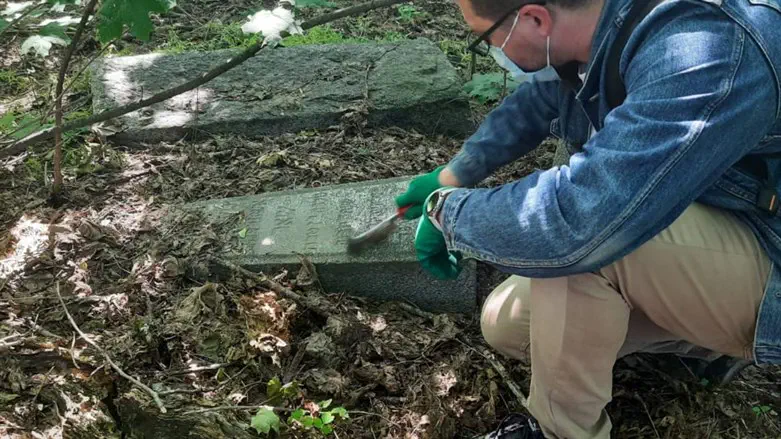
There are no less than 10,000 Jewish cemeteries in Eastern and Central Europe. This incredible statistic came to light in the expert and detailed survey that the European Jewish Cemeteries Initiative (ESJF), an international organization dedicated to the locating, mapping, and preservation of Jewish cemeteries, conducted for the European Union.
The immense number shocked even the most experienced experts in the field. They believed that there weren’t more than a few hundred cemeteries that had survived the Holocaust and the passage of time.
Before the Holocaust there were around 20,000 Jewish cemeteries in Eastern and Central Europe; half of them have been erased from the face of the earth. Sadly, the physical condition of those that remain is deplorable, most of which have been exposed to the unfortunate ravages of time.
Neglected burial site damaged by harsh weather over the decades, anti-Semitic fueled destruction, and careless greed which saw the purchase of the abandoned land for the construction of residential and office buildings, shopping centers and sports fields. A small minority of the cemeteries have astonishingly been preserved, despite no Jews visiting them in decades.

A team of ESJF experts that conducted the survey went from country to country, researching, investigating, and measuring in every city, town, and village.
The team utilized every tool available to them - old maps, modern and historic aerial photos, advanced technological devices such as drones and UAVs, and testimonies from the locals – to map and define the exact boundaries of the cemeteries. ESJF now has a digital file for almost every single one of the thousands of cemeteries that have been surveyed.
Hundreds of mass graves spanning across Eastern Europe of those murdered by the Nazis were added to the list of thousands of cemeteries. The condition of both the cemeteries and the mass graves are atrocious and in the seventy-seven years that have passed since the end of the Second World War many cemeteries have been destroyed. The graves of many tzaddikim - righteous religious leaders - that were seen as spiritual centers, drawing the masses to them, were razed to the ground.
These cemeteries were one of the first targets in the Nazis’ genocidal plans as they knew exactly how important the cemeteries were to the Jewish people. Our parents and grandparents, our roots, our past and our history – these are the foundations that a Jew survives on and are expressed in every cemetery, which the Nazis sought to destroy.
The survey, undertaken in an unprecedented scope, is just one of the projects organized and conducted by ESJF, the organization that has set its goal to save Europe’s Jewish cemeteries. Over its seven years of existence ESJF has achieved unprecedented results, having preserved and protectively fenced 225 cemeteries in five countries (as of October 2021).
225 cemeteries! An incredible achievement and the first of its kind since the end of World War II.
What is the ESJF?
Every traditional Jew knows about Mezhibuzh, Lezhinsk, Gur, Kotzk, Vizhnitz, Kasov, Uman, Lublin, Kerestir, and dozens of other places where the most righteous of our people lay in their eternal rest, and where thousands flock to pray.
But are these the only cemeteries in Eastern Europe? Rav Yitzchak Yehuda Schapira, the founder of ESJF, invested his time, strength, energy, and money, utilizing his extensive relationships with heads of state and international organizations to save the cemeteries and preserve the dignity of the millions of Jews buried in them.
Rav Schapira drew on his contacts across the globe and founded ESJF for the sole purpose of locating and fencing off the cemeteries across Eastern and Central Europe in an effort to prevent their further destruction.
The organization operates with the highest professional standards and with great transparency, under the halachic guidance of the posek, Hagaon Hagadol Rav Elyakim Shlesinger, shlit”a, of London.
ESJF’s ultimate goal translates to hundreds of kilometers of high-quality walls and fencing, creating barriers that protect the cemeteries. The sturdy barriers are the difference between an accessible and dilapidated space, open to the desecration of anyone who chooses to use it as they choose, and a protected holy area, a monument to the Jewish communities that once were and are no more, where the deceased can rest in peace.
Even during these past two years of the Covid-19 pandemic, despite all the difficulties it entailed, the work did not stop.
During this period dozens of cemeteries were protected – in the town of Yampil, Vinnytsia Oblast (region), in south-western Ukraine, where 345 meters of protective wall were erected; in Briceni, in northern Moldova, where a 5000 meter wall was built; in Dobroca, a town in western Ukraine, where the cemetery had been broken into and desecrated; in the cemetery in Kamenetz-Podolski in south-western Ukraine that was completely breached with only 40 headstones still standing, 480 meters of protective walls were built; in the cemetery in Valea lui Vlad (Dumbrovita) in northern Moldova where there are more than 200 headstones, 303 meters of wall were erected; the Jewish cemetery in Leshniv between Lvov and Rivne in western Ukraine was walled in with 273 meters of fencing.
Another cemetery whose preservation was recently completed is the one in Sudilkov in western Ukraine – the hometown of Harav Hakadosh Rav Moshe Chaim Efraim zt”l, the Degel Machaneh Efraim.
The cemetery there, with only around 200 headstones remaining, was protected with 529 meters of walls. The preservation of this cemetery was given top priority to save it from disappearing completely as has happened to most of the cemeteries in the Lvov region.
As Rav Schapira relates, “Of the twenty thousand cemeteries that existed in Europe, only ten thousand remain. The condition of the cemeteries is horrifying. The cemeteries where our fathers and rebbeim are interred have become valuable properties for real estate sharks.
Places that used to be outside of the municipal boundaries or at the edges of cities are now valuable locations inside the city; houses and factories were built over the graves. In some places the bones of the deceased were removed from the graves that were purchased and dug for them, and in their place local non-Jews were buried.
Our organization raised an outcry and raised the awareness of the Jewish world to our responsibility to save the many cemeteries that still exist. Everyone is considered the relative of a meis mitzvah!”, he concludes, crying out from the depths of his heart.
“Our current pace is not sufficient”, Rav Schapira says worriedly. “At this pace it will take hundreds of years to preserve and fence all the cemeteries, if anything will be left of them then. Our vision is to restore 300 cemeteries a year. It is possible, we have the best professionals in the field and ties with many governments and local authorities, all that remains is for Klal Yisrael to do its part.” This is a call to every Jew to fulfill his responsibility to his forefathers and to his nation and help save the cemeteries in Europe.
Thanks to the mapping project that was undertaken with the financial help of the European Union, many cemeteries whose existence had been unknown were discovered. In Ukraine, for example, where there was thought to be around 700 cemeteries, the survey revealed double that – around 1400 cemeteries! ESJF estimates that there are actually around 2000 cemeteries there and a similar number of mass graves.
In Belarus, there were around 250 known cemeteries and the survey brought on the discovery of another 150 sites. In Greece, the survey found 28 more cemeteries than the 20 already known to exist and a similar path of discovery continues throughout the continent.
The organization receives financial support from the German government, the European Union, the Schapiro family, and from the donations of individuals. Although ESJF manages its finances responsibly, efficiently and with complete transparency, this is not enough.
The support of Klal Yisrael is critical! Meis mitzvah - everyone is His relative! All of us, as one, must join together to support this holy and humanitarian mission to save the dignity and eternal rest of those who have passed on.
As the Ramban writes (Bereishis 23,19), “the reason that the Torah tells us the resting place of the Avos Hakedoshim is to teach us that we are obligated to afford respect for the place that our holy fathers are buried”.

